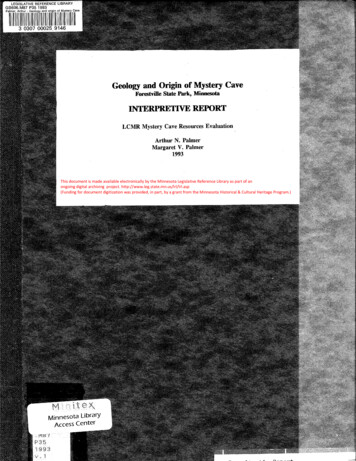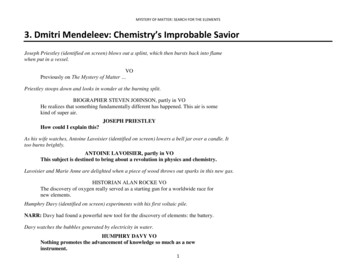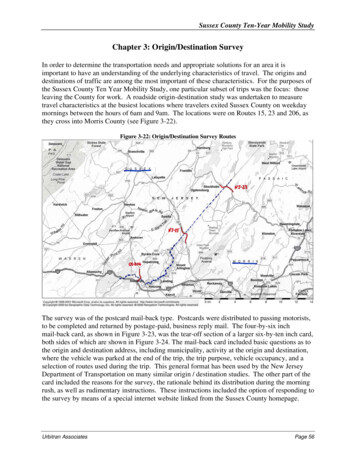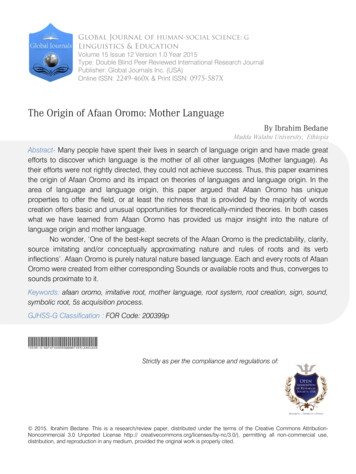
Transcription
LEGISLATIVE REFERENCE LIBRARY 'l li fil r1 fi1 t1 i1i l1 1 1 1 1 i1 1 i1 1r3 0307 00025' 9146Geology and Origin of Mystery CaveForestville State Park, MinnesotaINTERPRETIVE REPORTLCMR Mystery Cave Resources EvaluationArthur N. PalmerMargaret V. Palmer1993This document is made available electronically by the Minnesota Legislative Reference Library as part of anongoing digital archiving project. http://www.leg.state.mn.us/lrl/lrl.asp(Funding for document digitization was provided, in part, by a grant from the Minnesota Historical & Cultural Heritage Program.)
ACKNOWLEDGMENT:Funding for this project was approved by the Minnesota Legislature M. L. 91, Chapter 254,Article 1, Section 14, Subd. 3(1), as recommended by the Legislative Commission onMinnesota Resources, from the Future Resources Fund.COPYRIGHT 1993 STATE OF MINNESOTADEPARTMENT OF NATURAL RESOURCESFOlmSTVILLE STATE PARK
GEOLOGY AND ORIGIN OF MYSTERY CA VE./Interpretive ReportArthur N. Palmer and Margaret V. PalmerDepartment of Earth SciencesState University ofNew YorkOneonta, NY tionMethods of studyLeveling surveySampling of bedrock, speleothems, and waterMapping of the rock strataRefraction seismologyGeochemistryVibration studyLaboratory analysis of samplesGeology of Mystery CaveBrief geological backgroundRock strataSedimentary environmentsOrdovician rocks of southeastern MinnesotaOrdovician fossils in the Mystery Cave areaRocks exposed at Mystery Cave. .Easily recognized beds in Mystery CaveGeofogic structureGeomorphic settingWater chemistryCave mineralsSpeleothems in Mystery CaveUnderwater speleothemsSpeleothems formed by dripping and flowing water·speleothems formed by capillary seepageSpeleothem colorsIron oxide in speleothemsChalky crusts on desiccated speleothemsBacterial filaments in speleothemsNon-chemical deposits in Mystery CaveSedimentOrganic debrisBreakdownOrigin and developmental history of Mystery CaveComparison with other cavesNoteworthy features along the tour routes in Mystery CavePresentation of geologic information to tour groupsConclusionsReferencesAppendix -- Frequently asked questions about Mystery Cave
2INTRODUCTIONThis is the interpretive portion of the final report for the project Mystery Cave GeologyResources Evaluation (part of the Mystery Cave Resource Evaluation). This project concerns thegeology, mineralogy, and origin of Mystery Cave. A summary of the technical aspects of the project isgiven in a separate Technical Report, and recommendations for further study and managementsuggestions are given in a separate Management Report. This Interpretive Report contains the mainconclusions from the project, including background material, setting, general description of methods, adetailed description of cave features and their interpretation, and a discussion of the cave origin. Thisis the main document describing the results of the project in non-technical terms and is supplementedby the Technical Report, which contains quantitative details. Although these reports provide an· adequate summary of the geology and origin of the cave, they are only preliminary. An expanded andupdated version will be submitted in 1994.·Mystery Cave, is the largest cave in Minnesota (see topographic setting and cave map onFigures 1 and 2). The two entrances of the cave, plus the land around them, are administered by thestate Department of Natural Resources at Forestville State Park, and interpretive tours are run for thepublic in both sections by DNR staff. The purpose of this report is to enhance the interpretive andmanagement programs of the Park by providing a comprehensive reference to the geology and originof the cave.This study provides a descriptive inventory of the natural features within the cave andinterprets how they formed. The cave is like a natural laboratory where a surprising number offeatures, rarely preserved on the surface, are left relatively undisturbed in a protected environment.The interpretation of these features helps to understand the evolutionary history of the entiresurrotmding region. For example, glacial sediment is poorly exposed at the surface, but there are wellpreserved and very old glacially derived sediments in Mystery Cave. Certain features that are activelygrowing in Mystery Cave are very rare, and studying them has helped to better explain these featuresin other caves elsewhere.Acknowledgments: Funding for this project was approved by the Minnesota Legislature M.L. 91, Chapter 254, Article 1, Section 13, Subd. 3(1), as recommended by the Legislative Commissionon Minnesota Resources, from the Future Resources Fund. Several people helped considerably in thefield work for this project. Warren Netherton, Cave Specialist at Mystery cave, provided inspiration,enthusiasm, and continual support throughout the project. He and his family did a great deal to makeour visits memorable. Calvin Alexander and Roy Jameson of the Department of Geology andGeophysics at the University of Minnesota, and Richard Lively of the Minnesota Geological Surveygenerously conitributed their ideas and information about the cave. The Mystery Cave staff gave usmuch encouragement and guided us in searching out the questions that most needed answerihg. Oursincere thanks to them all.
,- .-Figure 1: Location of Mystery Cave on the Cherry Grove and Wykoff USGS Quadrangles.w
MYSTERY IllMYSTERY IITHE MYSTERY CAVE SYSTEMFillmore County, MinnesotaMN23:C0001Surveyed by theMinnesota Speleological SurveyFebruary 1 984Survey Length: 18.98km (11.80 miles)Computer Data Baae and Oraphica by'.2!1fP.II·'I.1Clf.etlf,.,s:A.f-ffETII ,III syISlU-f 1'EftSI. II.2alPa111 Scoblee - ENTRANCENFigure 2: Map of Mystery Cave, surveyed by the Minnesota Speleological Survey. -.:i ?h --' '" f:. ,,,,.; '";;:,;n,,.4c C:;,.,'-,-- - L."",:,J;;;. "7 ,-- - --- ----":""' , .,. ,, "-- -;-----0---.,,.
5METHODS OF STUDYField and laboratory methods used in the preparation of this report are briefly describedbelow, along with the major results. They are discussed in greater detail in the Technical Report.Leveling SurveyTo map the geology and its relationship to the cave, we leveled all the major passages in thecave (and some minor ones) with a tripod-mounted surveyor's level. This survey provided very precisevertical measurements, which are essential for a valid geologic interpretation. The horizontal layout ofthe survey was obtained from bearings measured with a SUUNTO compass, and distances werecalculated from stadia readings made with the level. Where the passages were too small for the tripodmounted level, a hand level and rods were used, along with a fibreglass tape and SUUNTO compass.Notes included continuous sketches of profiles plus and pertinent cross sections and descriptiveinformation. At each station we measured upward or downward to the ceiling, floor, bedding planes,geologic contacts, sediment levels, water levels (past and. present), and other noteworthy features.Bench marks were established in convenient places, mostly on natural features such as the tips ofstalagmites. Where natural features were not available, an inconspicuous 11 11 was chiseled into thebedrock or on breakdown slabs, as requested by DNR. The 112 bench marks are listed in Appendix 1of the Technical Report. Survey information is summarized in Appendix 2 of that report.The geologic profile of the mapped passages is shown in the 20 sheets enclosed separatelywith these reports. For further details, see the section entitled Geologic Profile of Mystery Cave in theTechnical Report.Sampling of Bedrock, Speleothems, and Water· Loose chips of bedrock and broken speleothems were obtained in a non-destructive way,leaving no observable damage. Collecting in a cave should be done in the most discrete way possible,and only for projects that will provide a clear benefit to the interpretation of the cave. All strata in thecave were sampled, a total of 76 beds. In addition, 57 speleothem fragments and 4 sediment sampleswere obtained. the latter are relatively few, as the sediments had already been studied extensively byMilske (1982), and by Milske, Alexander, and Lively (1983). Sampling sites fo rocks, minerals, andsediments for this study, plus sediment sampling sites of Milske (1982), spleothem samples used for ·- .Urrh dating by Lively (Milske, Alexander, and Lively, 1983) and for this report are shown in theAppendices of the Technical Report. A few water samples were taken for chemical analysis tocorrelate with our mineralogical observations. Water chemistry was the main focus of the LCMRHydrology Project, and so our geochemical sampling and measurements were done simply to clarify a·few mineralogical questions.Mapping of the Rock StrataEach bed in the limestone exposed in the cave was mapped during the survey. Thestratigraphic section is shown in Figure 3 and is described in detail later in this report. Three rockformations are exposed in the cave: from lowest (oldest) to youngest, they are the Stewartville,Dubuque, and Maquoketa Formations. For convenience in mapping and identification, we identifyindividual beds with unofficial code names. Beds SX 1 through SX3 are granular, crystalline beds neartop of Stewartville. DTl through DT4 are transitional beds at base of the Dubuque, with little or no
6shale between them. BPI through BP3 are major bedding planes near the base of the Dubuque. DLIthrough DL29 are limestone beds in the Dubuque sandwiched between thin shale beds. DS 1 throughDS30 are the thin shale beds that separate the limestones in the Dubuque. Individual beds and contactsbetween beds are identified on the geologic profile by these code names. Contacts are indicated as inthe following example: DS 11/DLl 0 contact between shale bed DS 11 and the underlying limestonebed, DLIO. The code names for the thin limestone and shale beds may seem awkward at first, but theadvantage is that in the field it is possible to count quickly upward or downward from a known bed,using only the projecting limestones or the recessive shales, without having to keep track of every bed.It is appropriate to interpret each shale/limestone sequence as beginning with an influx of mud into theshallow sea, followed by a quiet period in which limestone is deposited. The alternation between shaleand limestone therefore begins with DS I (the first shale) followed by the corresponding limestone(DLl), then by the next sequence (DS2 and DL2), and so on.The terms "limestone" and "shale" are used rather liberally in this description. As explained inthe sections on interpretation of the bedrock, most of the limestones are highly dolomitic, and most ofthe shales are a combination of limestone and shale and so are technically limy shales or shalylimestones.Refraction SeismologyA portable refraction seismometer was used to determine depths to bedrock in the valley of theSouth Branch of Root River near the Mystery I entrance, as well as a few other locations. To use theinstrument, shock waves are generated at the surface with a sledge hammer on a thick aluminum plate.They are detected by a seismometer implanted in ·the soil at varying distances from the hammer. Thetravel time to the geophone for the first wave arrival is recorded on the seismograph. By comparingthe travel time with the distance between the hammer and seismometer, wave velocities through theground can be determined. At small distances the velocity is that of the·soil (around 1000 ft/sec), butat larger distances the waves that arrive first are those that travel deeper into the ground throughmaterial that transmits the waves at a higher velocity (at Mystery Cave the weathered surface of theunderlying limestone bedrock, which has a seismic velocity of about 10,000 ft/sec). The deeper wavescan be detected because they refract back up to the surface, just as light is refracted through a lens,and be ause of the higher seismfc velocity of the lower material, the deeper waves actually reach theseismometer first. (These are not waves that are simply reflected off the bedrock surface, as theywould never reach the surface faster that the direct wave through the soil.) By calculating the wavevelocities and the point at which both the direct and refracted waves arrive simultaneously, it ispossible to find the depth of the bedrock below the surface -- i.e., the thickness of the soil or sedimenton top of the bedrock.The method of analysis is described in detail in the section on Refraction Seismology in theTechnical Report. At Mystery Cave the depth of sediment in the valley of the South Branch of RootRiver is about 20-25 feet. Therefore, the valley was that much deeper before it was partly filled withsediment during glaciation. Most of the sediment appears to be wind-blown silt carried in from areasof exposed glacial sediment. It is interesting to note that the sediment in the valley is not saturated withwater. The water table (the top of the zone in which all openings in the ground are filled with water)lies at or below the sediment/bedrock contact, at least 20-25 feet below the surface. This means thatthe South Branch is perched 'above the water table on the dry, rather impermeable silt. No wonder itloses its water to solutional fissures wherever it comes in contact with the limestone.:-- ·
z0 -- -- ,.,Maquoketa Formation: Shely llmy dolomite, Incompetent, foull-rlch, andgray-brown, with a few beds of llmy shale. Dolomite content Is 50-90% Inmost beds. Approxlmately 17 feet of Maquoketa Is exposed In Mystery Cave,mainly by breakdown Into large near-surface rooms. Forms celllng ofCathedral Room, the entrance rooms of Old Mystery and Old Still Ceves, andthe upper half of the cllff at the Grotto near the Mystery I entrance.Weathers to a soft allty muck In moist areas of the cave. Distinguished fromthe underlying Dubuque Formation by Its general lack of rhythmlcallyalternatlng limestone and shale beds.0::010u.----- 01------::: 0 ·-: : ot.21ot. 2t: -::-:.:.::.:: .,.8i-----.-.-.-DS21Ol27OS27 -: .:OS28·.: .i.Cl !I10 -&.- ·:zI :-L-3--;.:-."'\.:.0::0u.::: 0::: m::: c20}--"" ""'.:-,I :: ,IOLIO oseOSI.3(30 DS7DLIDU OllOS&01.4DUOl.3083Ol -::'.E .8DU······· .·.·.40i.!. :.··.·· I,IIISX2II III4III0IIISXIII,1.50I . , ,.\·IIIII0::I0Ic,,w:i &f0:JIIejII\III\I60.IIIIIIIi isIIVIIll.a . .8 D/SII , IP1SU'1''\IIIP2DTII IrIIIIzDT2·.·. ·;,enOl.DL IDl 1DU.ii t-Dubuque Formation: Competent beds of gray limestone alternating withthin interbeda of recessive llmy shale. Total thickness at Mystery Cave la39-40 feet. Limestone beds (labeled DL) are generally B-12 Inches thick;shale beds (labeled OS) average about 1-3 Inches thick. A few shalylimestone beds reach thicknesses as much as 2 feet. One or two bentonltebeds 1-3 Inches thick near the mlddle and top of the formation. TheDubuque Is sometimes divided Into three members: The Frankvllle Member(lowest) consists of competent dolomltlc llmestone with prominent beddingplanes and thin shale partings In places. The limestone beds are labeled OT(I.e., transltlonal Dubuque beds), and the prominent bedding planes arelabeled BP. Dolomlte content Is 5-60X. The lower beds contain abundantsmall crlnold fosslls. The Luana Member consists of alternatlng limestonesand shales. Dolomlte content Is negllglble In most beds but reaches 1 " Ina few. The Llttleport Member (highest) ls similar to the Luana, except thatthe llmestone/shale alternation la not as regular and the dolomlte contentIs much higher, varying from 5'li to .cox. At other localltles the beddingplanes of the Llttleport are wavier than those of the Luana, but thischaracteristic Is not apparent at Mystery Cave. Contacts between themembers are rather arbitrary. The dolomite content Is a rational method fordistinguishing the three members, although It requires laboratory analysis.The contact between the Dubuque and the underlying StewartvllleFormation Is a matter of ·debate: In this column the contact Is placed at theupward change from rather maulve limestone mottled with foull wormburrows to well-bedded unburrowed llllle tone (generally equlvalent toBP1).Ol 17DltlDS11OS 15DL15DL 14OS 14Ol 13OS 13Dl t2OS 12 Ol. ttDSl1OSIOJu.DI. 21:: 0wM/DDL 25OS 25 Dl 2'DS24Dl.23OS 23 Dl 22OS22OS 21 Ol 2IOS20 DL20OL 11OS ti Ol ti :.-:. :.::- ":::.:. "":;17IIII70IIIStewartville Formation: Massive gray-brown dolomltlc limestonecontaining abundant mottling by fose:I dolomitic worm burrows. Dolomitecontent ranges from 1 " to 55X. Approximately 45 feet of Stewartvllle Isexposed In Mystery Cave. In cave surfaces the dolomitic burrows eitherproject from the walls or weather Inward to form pockets, depending on thenature of the weathering and the dolomite texture. The burrows projectoutward mainly where the rock has been re-exposed after having beenburled beneath cave sediment; the exact mechanism Is stlll under study. Afew thin beds of resistant, brown, crystalline limestone occur near the topof the Stewartville, which grade laterally Into prominent wavy beddingplanes. Apparently these horizons represent scouring by marine currentsor wave action. The contact with the overlylng Dubuque Formation Isarbitrary. Here the contact la considered to be the clear break betweenburrowed dolomltlc limestone and relatively pure granular limestone. Thischange causes a significant change In the weathered character of the cavewalls. This contact Is an approximate average of those designated byprevious authors. The Stewartville is considered by some stratigraphersto be the uppermost member ol the Galena Formation. Here the StewartvilleIs ranked as a formation within the Galena Group.IIIIIFigure 3: Stratigraphic column at Mystery Cave. See text for explanation of bed names.
8GeochemistryWater chemistry was not one of the primary goals of this project, since detailed infonnationon the subject is available from the group undertaking the LCMR Hydrology project. However, themajor geochemical concepts are described here, and a few measurements of water chemistry were.made for this study, because they concern the origin of the cave and its speleothems. The results are·summarized in the Technical Report.In general, the drip waters entering the cave are highly supersaturated and have a high carbondioxide (COJ content derived from the rich organic soil. The water rapidly loses C02 when it entersthe cave, depositing calcium carbonate at a rate faster than in most other caves. During low flow, riverwater that enters the cave is saturated with both limestone and dolomite and is unable to enlarge thecave further. However, during floods, the river water and cave water derived from it are highlyundersaturated and enlarges the cave.Vibration StudyThe seismograph was also used in the cave to measure the effect of surface disturbances incomparison with the background level of vibration. This study was rather preliminary, as ourequipment and facilities were rather limited, but in general it showed that normal traffic over the caveproduces almost undetectable vibration in comparison with background vibration from drips and othernatural sources.Laboratory Analysis of SamplesRock and mineral samples were sketched, photographed, and described under a binocularmicroscope at magnifications up to 40X. Fossils, basic structure, and most minerals could beidentified by this method. Some samples were immersed in mineral-specific stains that showed thedistribution of certain minerals (mainly calcite). Most samples (73) were then cut by diamond saw intothin slabs and mounted on glass slides with epoxy, then ground to about 30 microns thick (0.03 mm),which is thin enough ·that they could be viewed by transmitted light through a microscope. These ''thinsections" were interpreted and photographed with a petrographic microscope (magnification up to630X), which uses polarized light to produce colors that help in the identification of minerals and theirrelationships.Minerals that are too small to recognize under the polarizing microscope, or whose identity isambiguous, can be identified by powdering a small sample and determining its X-ray diffractionpattern. A thin layer of powder is placed on a microscope slide and is slowly rotated within an X-raydiffractometer while it is exposed to a beam of X-rays. The rays are scattered by diffraction and eachmineral has a distinctive set of peaks at which the outgoing radiation is most concentrated.The scanning electron microscope (SEM) is used to examine the surface characteristics of asample. Combined with the SEM is an EDX (energy-dispersive X-ray) unit that is able to identifyindividual elements within selected parts of the sample. This information complements that from theX-ray diffraction unit. It does not identify the minerals but helps to narrow the range of possibilitiesand gives information about their impurities.Results of these laboratory analyses are summarized in the Technical Report.
9GEOLOGY OF MYSTERY CA VEThe results of the geologic study are summarized here, with emphasis on those aspects of thegeology that pertain to the origin and layout of Mystery Cave and the features that it contains.BRIEF GEOLOGICAL BACKGROUNDMystery Cave is located in the southeast comer of Minnesota close to the Iowa border andshares the same regional geology as adjacent midcontinent states. The cave is developed in limestoneand dolomite of the Ordovician Period (pronounced OR-do-VlSH-ian), which are about 450 millionyears old. It offers fine exposures of bedrock, which nearly everywhere else in the region is buriedunder the much more recent glacial deposits. Although these rocks are also visible in a few outcrops,quarries, and road cuts, the rocks in Mystery Cave are much more continuous and are naturallyweathered, rather than freshly blasted (as in the quarries), and therefore subtle textures and geologicfeatures are much better displayed.To put the geology of Mystery Cave into its proper context, a little background information isappropriate. The earth's hard outer crust is composed of rocks that fall into three groups: igneous,metamorphic, and sedimentary. Igneous rocks crystallize from molten lava and originate wheremountains are actively fonning. Metamorphic rocks are formed from preexisting rocks by heat andpressure. Sedimentary rocks consist either of chemical precipitates or fragmental material from theweathering of other rocks. At and near the surface in the Mystery Cave area, the rocks are allsedimentary. Sedimentary rocks are laid down in lay rs at the earth's surface at normal temperaturesand pressures, and so they preserve many clues to the surface conditions that existed when they weredeposited.Rocks made up of weathered fragments of other rocks are called elastic rocks and werecarried by water, air or ice before being deposited as layers. Clastic rocks are classified by the sizeand mineralogy of the grains. Microscopic fragments less than 4 microns (1/256 mm) in size are calledclay. Clay minerals are complex compounds rich in silicon and oxygen that also include such elementsas aluminum and magnesium. They are typically the weathering products of igneous rocks.Sedimentary rocks composed of solidified clay are called shale, a soft, flaky rock that is easily eroded.Particles between 1/256 and 1/16 mm in diameter are called sih, which forms the rock siltstone. Sandis between 1/16 and 2 mm in diameter and forms the rock sandstone. Siltstone and sandstone have therespective textures of very fine and coarse sandpaper. Sandstone is rather resistant and often forms ·cliffs. Siltstone is intermediate in characteristics between sandstone and shale. Larger erodedfragments are called gravel, which forms the rock conglomerate. The major mineral in silt and sand(and to some extent conglomerate) is quartz, which consists of crystalline Si02 . These sedimentaryrocks are formed from their constituent sediments by compaction and by being cemented together byprecipitated minerals.·, ,, ,:\Chemical sedimentary rocks include limestone (composed mainly of the mirieral caldte,CaC03), dolomite (CaMg(C03)J, and gypsum (CaS04 ·2H20). These are the ones in which mostlarge caves are formed. Chert is microcrystalline quartz, (commonly known as flint) which is usuallydeposited as a chemical sediment or replaces other rocks. A simple way to differentiate betweenquartz of any kind (including chert) and the other chemical sedimentary rocks is that quartz willscratch glass while the others will not. Dilute acid (e.g., 10% hydrochloric acid) will cause calcite to" :'Ji,.·i.
10fizz like a can of soda whose top has just been removed. Dolomite also fizzes in acid, but very slowly,and usually only if it is powdered first. Limestone and dolomite are usually gray and are fairlyresistant to mechanical erosion. They are able to stand up as cliffs because of this; but they also formcaves because they dissolve in water. Gypsum is a white to light gray rock so soft that a fingernail willscratch it. It is so soluble that it is normally dissolved away completely at the surface in humidclimates.Mystery Cave offe-rs a fine chance to see limestone, dolomite, shale, and various combinationsof all three rock types. It is immediately clear that the rocks were laid down in nearly horizontal layers,which are called beds. Each bed represents a rather continuous deposit of sediment. Contacts betweenbeds are called bedding planes. These are formed by breaks in the deposition or changes in the type ofsediments being deposited. Some bedding planes are nearly flat, whereas others have wavy reliefindicating irregularities in the sedimentary deposit, or disturbance of the sediment surface, for exampleby erosion.One of the most useful aspects of sedimentary rocks is that the layers deposited on top arealways younger than those below. This is called the law of superposition. In the 1800s geologists were ,just beginning to recognize the different rock layers. They discovered that they could trace the bedslaterally from one area to another, because some beds had unique features that could be easilyrecognized. These features included fossils, which are the remains of extinct organisms. Usually onlythe hard parts such as the shell remain. They could even trace rocks of the same age from continent tocontinent using fossils. Rocks all over the world could be separated into groups whose boundariesrepresented periods of erosion. Where the eroded surface of old rock layers is overlain by youngerrocks, the irregular contact is called an unconformity. On ·the basis of these· major groups ofsedimentary rocks and the unconformities between them, a geologic time scale was deyised. This timescale consists of several Eras and Periods, as shown in Table 1.A continuous sequence of sedimentary beds having approximately the same character (such assandstone) is called a formation. Each formation is given the· name of the place where it was firstdescribed. For example the Stewartville Formation, which is seen in the lower levels of Mystery Cave,was named in the early 1900s for exposures near the town of Stewartville in Olmsted County,Minnesota. Rock types change their character from place to place, for example from limestone toshale, because of changes in the depositional environment changes. So the limestone and the shalewould each be given a different name, although they were deposited at the same time. In this way aformation can change laterally to a different formation of the same age in another area. Furthennore, ·the boundaries are highly gradational. Thus the naming of a rock formation is not at all as simple as itmight seem.The rocks of the Mystery Cave area were deposited during the Ordovician Period, about 438504 million years ago. Mystery Cave itself was formed by the dissolving of some of these Ordovicianlimestones by underground water over the past 0.5-1 million years, during the Quaternary P riod. Allbut the last 12,000 years or so of the Quaternary Period consists of the Pleistocene Epoch, when largeparts of the world were covered periodically by glaciers.Dating geologic events such as the origin of rocks or the formation of a cave is one of themajor tasks of a geologist. In most cases it is possible to work out the relative ages of geologicfeatures and events by using clues and relationships such as the law of superposition. For instance, weknow that Mystery Cave is younger than the rocks that it is in, because those rocks had to be dissolved
IIin order to form the cave. Likewise, we know that the sediment in the cave is younger than the cave.Beyond that, things get more complicated.Absolute ages are harder to come by. These represent measurements or estimates of the ·actual age of a geologic feature or event. Radiometric dating is a major tool. Natural radioactivematerials in certain rocks break down at known rates, so when the ratio of parent to daughter elementis measured, it is possible to determine the age of the rock. The time scale is based mainly onradiometric age determinations and is revised as better dating techniques are developed. The geologictime scale was developed in Europe and initially reflected breaks in deposition, but because these rockbreaks vary slightly from continent to continent, the time scale today does not necessary coincide withmajor rock breaks any more, but it is still useful as a yardstick to show us how old the rocks are.Table 1: The geologic time scale.AGE (millions of ERAyears ago)0-2.2-70CENOZOICPERIODMAJOR EVENTSQUATERNARYGlaciation, origin of ICTRIASSICdinosaurs, first birds DEVONIANSILURIANII 600MISSISSIPPIANORDOVICIANrocks at Mystery CavedepositedCAMBRIANPRECAMBRIANEarly evolution of the earth;simple plants and animals
12Periods when rocks were being
5 Methods of study 5 Leveling survey 5 Sampling of bedrock, speleothems, and water 5 Mapping of the rock strata 6 Refraction seismology 8 Geochemistry 8 Vibration study . Mystery Cave, is the largest cave in Minnesota (see topographic setting and cave map on Figures 1 and 2). The two










